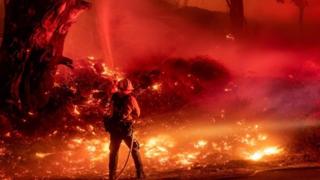Deadly California Wildfires
"It's the reality of the conditions we are facing that we absolutely can't underestimate the potential of how quickly these fires can get into communities."
"Everybody wants to take these conditions very seriously."
"Once a fire hits a community, it's too late."
Ken Pimlott, firefighter Cal Fire
"I think people are listening more."
"In the past there'd be evacuation orders and people would blow them off. After last year, they aren't doing that."
"With the winds blowing, it moved fast. In the middle of the night, if you're told to go, you go."
Mary Lindsey, 64, Charles Lindsey, 68, Santa Clarita
 |
Last year's dreadful tragedies has resulted in power companies, fire and law enforcement agencies and above all, residents of vulnerable areas, becoming ultra cautious to be able to respond when such instant, destructive fires arise. Fires in Santa Clarita north of Los Angeles stretched across 1,870 hectares to destroy 20 homes at the end of October. Firefighters are battling the Kincade blaze in Northern California where more than 31,000 hectares has burned as of 30 October, and still persisting as residents urgently prepared for a widespread blackout, high winds threatening, the utility deciding to shut down proactively.
/cdn.vox-cdn.com/uploads/chorus_image/image/65617284/GettyImages_1177955420.0.jpg) |
Residents now have little option but to have resigned themselves to their new reality. A constant state of preparedness to react when the next disaster hits. The stress and continual tension certainly detracts enormously from their quality of life. Constant vigilance is a strain, wearying and a mental distress which will inevitably have its consequential reaction on their state of comfort with where they live having become a factor in diminishing confidence. Where people maintain vehicles with full gas tanks and constantly sniff the air for tell-tale smoke.
The Santa Clarita fire ignited in a canyon on October 24, then exploded within hours to encompass thousands of hectares of land. By October 25, no fires were actively burning in the Santa Clarita Hills, so evacuation orders were lifted but only some of the tens of thousands who had returned to their homes were warned to be vigilant for hazards such as ash and damaged utilities. Reflecting concerns that the fires could be rekindled as strong winds moved back through the area
 |
| Fierce fires have burned thousands of acres of California AFP |
The Camp Fire last year swept through the town of Paradise in the morning hours, leading to a situation where people were unable to leave their homes and burned to death, and this is the new reality, where fires move faster than they have in the past, and people are left with no time to react. And then there is the rumour yet to be proven that the Kincade Fire might have begun when electrical equipment operated by Pacific Gas & Electric was not shut down when the company turned power off to 200,000 customers, failing to cut power to a transmission line that malfunctioned moments before the fire began.
Labels: California, Evacuations, Wildfires
0 Comments:
Post a Comment
<< Home